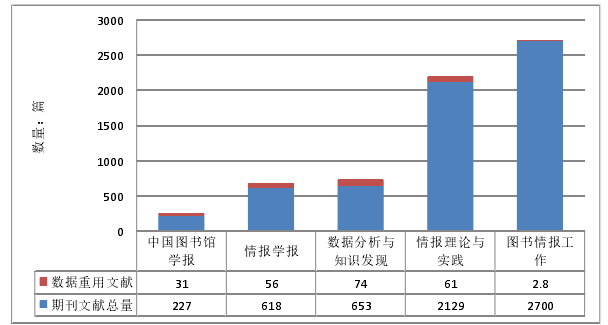本文研究了图情领域科研数据重用行为的现状和影响科研人员进行数据重用的因素两部分。对于第一部分,首先,采用文献调研和内容分析的方法,对科研人员数据重用行为进行了探索,得出结论,科研人员的学历越高,进行科研数据重用的可能性越大;高校的科研人员是进行科研数据重用行为的主力军;层次等级越高的机构进行科研数据重用行为的越多;科研数据重用规范存在不标准的情况,这与数据类型有关系,应该完善不同数据类型的引用标准;在图情领域,进行科研数据重用的数据类型主要是数据集、语料库和词典。同时,为了更近一步了解科研数据重用的特点,对科研数据自建行为进行了分析,对比两种行为最后总结得出,二者在科研人员特征、组织环境方面并没有太大差异;在科研数据类型上存在一些差别,相对于数据自建行为建立的数据类型大多是数据集类型,科研数据重用行为使用的数据大多是语料等文本类数据。最后,对科研数据重用文献和自建文献使用LDA主题模型进行挖掘,证实二者在研究主题方向存在差异。
对于第二部分,首先在调研与本研究相关的文献的基础上,提出科研人员数据重用行为意愿影响因素的八个变量,即科研人员特征、内部资源支持、研究主题、感知质量、感知风险、内部动机、外部动机和重用意愿,以重用意愿作为因变量,提出七个假设。接着,采用问卷调查的实证研究方法,以科研人员为目标对象进行发放问卷;最后,分析问卷,对数据进行描述性统计分析、信效度检验、单因素方差分析、多元回归假设检验和逐步回归多元模型,最后得出研究主题、感知质量、内部动机、外部动机对科研数据重用意愿产生正向影响;感知风险对科研数据重用意愿产生负向影响。
对于科研数据重用文献的调研不够全面,期刊类型较少,文献数量不够多;没有对科研人员所使用的数据进行具体追踪,分析数据来源的可靠性;样本容量不够大,调查人员学科领域分布不均匀;被调查者职业角色不够全面,主要侧重于高校硕士生;所属机构也比较单一。由前文分析可知,不同的学历背景与职业机构的科研人员对于数据重用的看法存在差别,期望在未来的研究中将样本量扩大,同时有区别性的对待不同学科领域的科研人员分别进行调查。对于影响科研数据重用行为意愿的变量不够全面,一些变量与科研数据重用意愿之间可能存在的关系没有得到证实,期待在未来研究中,提出更多变量并进行验证,完善影响科研人员数据重用意愿的影响因素分析,更好的促进科研数据重用的发展,发挥数据资源的价值。
参考文献
[1]姜鑫.国际图书情报领域“科学数据”研究进展述评——基于 SCI/SSCI 期刊论文的内容分析[J].现代情报,2018,38(12):144-150.
[2]左建安,陈雅.大数据时代的科学数据共享模式研究[J].新世纪图书馆,2014(03):32-35.
[3]刘晶晶,马建华.论科研数据开放共享的三种途径[J].情报杂志,2015,34(10):146-150+96.
[4]M.Law.Reduce,Reuse,Recycle:Issues in the Secondary Use of ResearchData.IASSIST Quarterly,29(1),5-10.
[5]Wallis J C,Rolando E,Borgman C L. If We Share Data,Will Anyone Use Them?Data Sharing and Reuse in the Long Tail of Science and Technology[J].PlosOne,2013,8(7):e67332.
[6]Mccall RB.Some issues of conducting secondary analyses.[J].DevelopmentalPsychology,1991,27(6):911-917.
[7]Kriesberg A,Faniel I M,et al.The role of data reuse in the apprenticeshipprocess[C].Asis&t Meeting:Beyond the Cloud:Rethinking InformationBoundaries. American Society for Information Science,2013:17.
[8] Yoon A. Data reusers'trust development[J].Journal of the Association forInformation Science & Technology,2016,68(4):946-956.
[9]Faniel I M,Zimmerman A.Beyond the Data Deluge:A Research Agenda forLarge-Scale Data Sharing and Reuse[J].International Journal of DigitalCuration,2011,6(1):58-69.
[10]Birnholtz J P,Bietz M J.Data at work:supporting sharing in science andengineering[J].AcmSiggroup Bulletin,2003,24(1):339-348.
[11]Curty R G,Crowston K,Specht A,et al.Attitudes and norms affectingscientists' data reuse.[J].Plos One,2017,12(12):e0189288.
[12]Niu J.Overcoming inadequate documentation[J].Proceedings of theAmerican Society for Information Science & Technology,2015,46(1):1-14.
[13]Yakel E,Faniel I,Kriesberg A,et al.Trust in Digital Repositories[J].International Journal of Digital Curation,2013,8(1):143-156.
[14]Bawden D.Scholarship in the Digital Age:Information,Infrastructure,andthe Internet[M].The MIT Press,2007:636-637.
[15]Van House,N.A.Digital libraries and the practices of trust:Networkedenvironmental information[J].Social Epistemology,2002,16(1) :99–114.
[16]Kim Y,Yoon A.Scientists' data reuse behaviors:A multilevelanalysis[J].Journal of the Association for Information Science &Technology,2017.
[17]Rolland B ,Lee C P .Beyond trust and reliability:reusing data incollaborative cancer epidemiology research[C].Conference on ComputerSupported Cooperative Work. 2013:435-443.
[18]Scaffidi C,Shaw M,Myers B. Games programs play:Obstacles todata reuse[J].Proc.symp.user Interface Software & Technology,2006:9-18.
[19]Zimmerman A S.New Knowledge from Old Data[J].Science Technology & HumanValues,2008,33(5):631-652.
[20]Hyoungjoo Park,Sukjin You,Dietmar Wolfram. Informal Data Citation forData Sharing and Reuse Is More Common Than Formal Data Citation in BiomedicalFields[J].Journal of the Association for Information Science abdTechnology,69(11):1346-1354, 2018.
[21]Abella A,Ortiz-de-Urbina-Criado m,De-Pablos-Heredero C. Meloda,AMetric to Assess Open Reuse[J].El Professional de laInformacion,2014,23(6):582-588.
[22]Borgman C L. The Conundrum of Sharing Research Data [M].Journal of theAmerican Society for Information Science and Technology,2012.
[23]Joo Y K,Kim Y. Engineering researchers’data reuse behaviours:astructural equation modelling approach[J].ElectronicLibrary,2017,5(2):1141-1161.
[24]Austin C C ,Bloom T ,Dallmeier-Tiessen,Sunje,et al. Key components ofdata publishing: using current best practices to develop a reference modelfor data publishing[J].International Journal on DigitalLibraries,,017,18(2):77-92[25] 徐 延 强 . 大 数 据 时 代 与 数 据 重 用 [J]. 信 息 与 电 脑 ( 理 论版),2018(05):132-133+137.
[26]谢娟,龚凯乐,成颖,柯青.使用数据与引用数据间的补充或替代关系探讨[J].情报学报,2018,37(05):486-494.
[27] 赵蕊菡 . 科学数据论文的重用现状研究——基于数据期刊“Earth SystemScience Data”的引文分析[J].情报理论与实践,2017,40(11):52-57+72.
[28] 丁楠 , 潘有能 .数据引用索引工作机理与应用现状综析 [J].情报理论与实践,2014,37(06):59-62.
[29]彭洁,贺德方,张英杰.数字出版环境中科学数据引用的实现路径及策略调查分析[J].出版发行研究,2014(04):57-61.
[30]王雪,马胜利,佘曾溧,杨波.科学数据的引用行为及其影响力研究[J].情报学报,2016,35(11):1132-1139.
[31]文静,何琳,韩正彪.科研人员科学数据重用意愿的影响因素研究[J].图书情报知识,2019(01):11-20.
[32]李梅.开放环境下的数据引用探析[J].河南图书馆学刊,2017,37(11):128-130.
[33]李佳潞. 科研人员数据重用行为影响因素及促进策略研究[D].东北师范大学,2019.
[34]洪程,钱鹏.高校研究生科学数据需求与利用行为调查分析——以东南大学为例[J].国家图书馆学刊,2014,23(01):16-21.
[35] 沈 婷 婷 . 社 会 学 研 究 者 对 二 手 数 据 利 用 行 为 分 析 [J]. 情 报 理 论 与 实践,2016,39(05):95-100.
[36]张晓阳,李楣.基于胜任特征的研究生数据素养能力测评量表研究[J].图书情报工作,2017,61(08):89-95.
[37]张闪闪,刘晶晶,顾立平,崔文健,张卓然.科研数据内容重用中的权益问题研究[J].图书情报知识,2018(01):105-113+94.
[38]丁楠,黎娇,李文雨泽,白晋铭,潘有能.基于引用的科学数据评价研究[J].图书与情报,2014(05):95-99.
[39] 张 梦 霞 , 顾 立 平 . 数 据 监 管 的 政 策 研 究 综 述 [J]. 现 代 图 书 情 报 技术,2016(01):3-10.
[40]TaylorR S.Information use environments,in progress in CommunicationScience[M].Norwich,NJ:Ablex,1991:217-255.[41]Oliver RL.A Cognitive Model for the Antecedents and Consequencesof Satisfaction Decisions[J].Journal of Marketing Research,1980,17(4):460-469[42]Bhattacherjee A.Understanding Information Systems Continuance:AnExpectation-Confirmation Model[J]. MIS Quarterly, 2001, 25(3):351-370.
[43]Bauer R A, Consumer behavior as risk taking In R.S. Hancock(Ed.), DynamicMarketing for a Changing World[D].Chicago: American MarketingAssociation,1960(7):389-398.
[44]Barach J A. Advertising Effectiveness and Risk in the Consumer DecisionProcess[J].Journal of Marketing Research,1969,6(3):314-320.
[45]Cox D F, Rich S U. Perceived Risk and Consumer Decision-Making: The Caseof Telephone Shopping[J].Journal of Marketing Research,1964,1(4):32-39.
[46]Cunningham, S.M. The Major Dimensions of Perceived Risk. In: Cox. D.F.,Ed.Risk Taking and Information Handing in Consumer Behavior[C].HarvardUniversity Press,1967.
[47]Jacoby J, Kaplan L B, Szybillo G J.Components of Perceived Risk in ProductPurchase: A Cross-Validation.[J].Journal of Applied Psychology, 1974,59(3):287-291.
[48]Deci E L,Ryan R M.The general causality orientations scale:Self-determination in personality[J].Journal of Research in Per-Sonality,1985,19(2):109-134.
[49]Sheldon K M. The self ‐ determination theory perspective onpositive mental health across cultures[J].World Psychiatry, 2012,11(2): 101-102.
[50]Davis F D. Perceived Usefulness, Perceived Ease of Use, and UserAcceptance of Information Technology[J].MIS Quarterly, 1989, 13(3):319-340.
[51]何婷婷.语料库研究[D].华中师范大学,2003[52]Singletary M.Mass communication research:Contemporary methods and applications[M].New York:Longman,1994.
[53] 李 志 芳 , 邓 仲 华 . 国 内 开 放 科 学 数 据 的 分 布 及 其 特 点 分 析 [J]. 情 报 科学,2015,33(03):45-49.
[54]BLEODM,NGAY,JORDAN M I.Latent Dirichlet allocation[J].Journal ofmachine learning research,2003,3:993-1022.[55]Xiuze Zhou, Shunxiang Wu. Rating LDA model for collaborativefiltering[J].Knowledge-Based Systems, 2016, 110.
[56]Alberto Dellacasa Bellingegni, Emanuele Gruppioni, Giorgio Colazzo,Angelo Davalli, Rinaldo Sacchetti, Eugenio Guglielmelli, Loredana Zollo.
NLR, MLP, SVM, and LDA: a comparative analysis on EMG data from people withtrans-radial amputation[J]. Journal of NeuroEngineering and Rehabilitation,2017,14(1).
[57]Arnfred Sidse Marie,Moller Paul,Davidsen Annette Sofie.
Approachingpatients with hyperreflectivity and perplexity: an empiricalqualitativeinvestigation.[J].Trends in psychiatry and psychotherapy, 2018.
[58]BLEIDM,NGAY,JORDANMI.Latentdirichletal location[j].Joural of machinelearning research,2003,3(Jan): 993-1022.
[59]Sugimoto CR,Ni C,Russell T G,et al.Academic genealogy as an indicatorof interdisciplinarity:an examination of dissertation networks in Libraryand Information Science[J].Journal of the Association for InformationScience&Technology,2011,62(9):1808-1828.[60]GREENHOOT A F,DOWSETT C J. Secondary data analysis:an important toolfor addressing developmental questions [ J ] .Journal of Cognition andDevelopment,2012,13(1): 2-18.[61]邱皓政.量化研究与统计分析—SPSS(PASW)数据分析范例解析[M].重庆:重庆大学出版社,2013:209-303.
[62] 吴明隆 . 问卷统计分析实务— SPSS 操作与应用 [M]. 重庆 : 重庆大学出版社,2010:208-217.[63]Ajzen I. Constructing a Theory of Planned BehaviorQuestionnaire[J].Unpublished Manuscript Retrieved, 2006(7):861-871.










